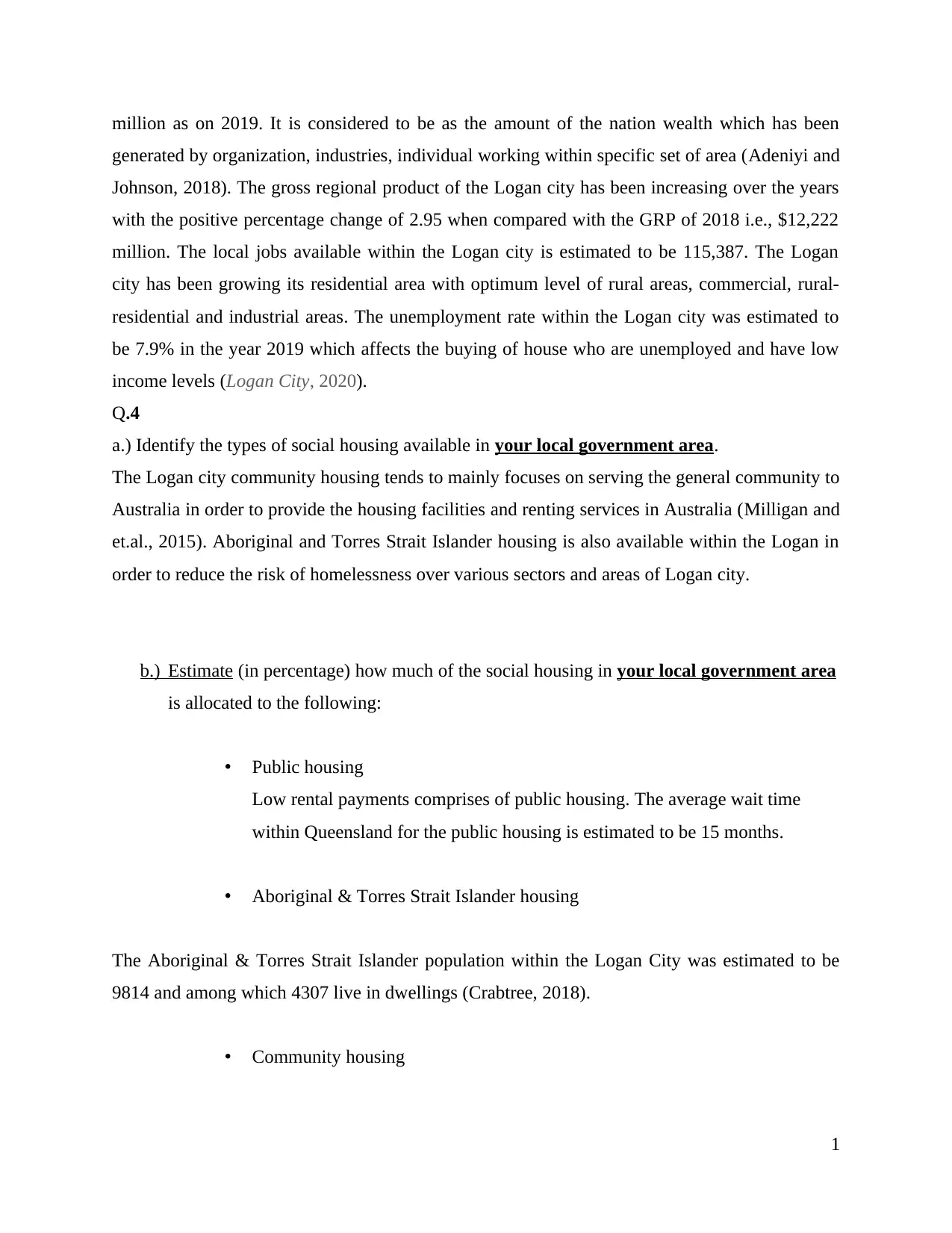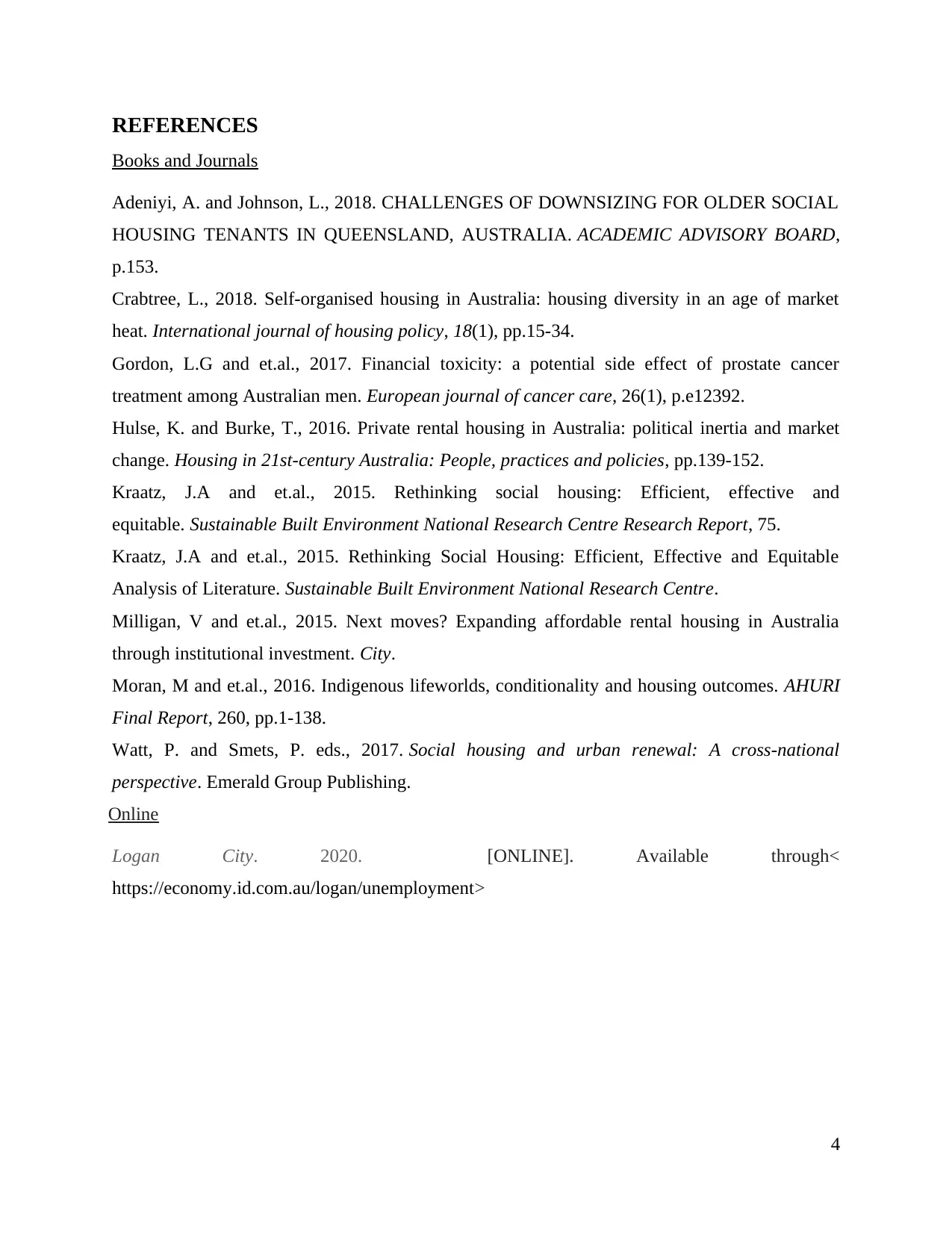Logan City Social Housing: Demographic, Economic, and Social Analysis
VerifiedAdded on 2023/01/10
|8
|1879
|32
Report
AI Summary
This report provides a comprehensive analysis of social housing in Logan City, Queensland, Australia. It begins by outlining the demographic characteristics of the area, including population density, socio-economic breakdowns, and principal industries, highlighting factors like the city's relatively affordable housing compared to Brisbane and the Gold Coast. The report then assesses how these demographics affect housing availability and affordability for disadvantaged groups, emphasizing the impact of population growth and income levels. Economic factors, such as the gross regional product and unemployment rates, are examined in relation to homelessness and social housing, detailing the types of social housing available (public, Aboriginal & Torres Strait Islander, and community) and their allocation percentages. Community housing providers are identified, along with the nature of the housing needs they address, including emergency, transitional, and long-term housing. The report also explores the role of the local council in community housing, including project sponsorship and land contributions. Finally, it considers whether the supply of social housing adequately meets demand, citing the long wait times for public housing and the need for increased social housing development in accessible areas.

Work with people experiencing or at
risk
risk
Paraphrase This Document
Need a fresh take? Get an instant paraphrase of this document with our AI Paraphraser

TABLE OF CONTENTS
MAIN BODY...................................................................................................................................3
REFERENCES................................................................................................................................4
MAIN BODY...................................................................................................................................3
REFERENCES................................................................................................................................4

MAIN BODY
Q. 1 Describe the main demographic characteristics of your local government area in terms of the following:
Population density and distribution
Logan city has been considered to be as a local government area which has been situated within the South of
Brisbane metropolitan area within South East Queensland, Australia. the population density of the Logan city is
estimated to be 326,615 with the density of approximately 340.93/Km2 as per the 2018 report. This in turn
shows the distribution of the people across the area.
Socio-economic breakdown (levels of income)
Within the Logan city, approximately 17.1% of the household has significantly earned income of around $2500
or more every week as per the 2016 report. The cost of renting and also owning a house is quite affordable
when compared with the Gold Coast and Brisbane (Kraatz and et.al., 2015). Developing an affordable living
strategy and affordable housing within Logan city for households who tends to have moderate and lower
income levels.
Principal industries/ employment opportunities.
Logan city tends to generate approximately $8.742 billion in Gross Regional Product every year and it also
have estimated 21,000 companies and industries. However, the key industries within the economy of the city
mainly includes retail, manufacturing, wholesale trade, social assistance, health care, transportation, postal
services, warehousing, etc. Logan city tends to have young work force where business within the Logan city
tends to generate approximately 72000 plus jobs. Education plays one of the key significant role in lowering
the unemployment rates within the Logan city.
Q.2 Assess how these demographic characteristics may affect housing availability and housing
affordability for disadvantaged groups in your local government area.
Logan is considered to be a growing city with the estimated growth of more than 1, 75,000 people over a
period of next 20 years. This in turn states that, increase in the population in turn tends to state that, there will
be rising needs of housing and renting of properties with the increase in population. There are also large
number of households who tends to experience stress related with housing because of low degree of income
levels (Watt, and Smets, 2017). The income based rent is one of the key issue which tends to result in low rent
on the larger properties. The community housing component provides apartment and complexes to the lower
income people. Lower level of employment opportunities to the people in turn tends to eventually result in
reduced level of renting or purchasing of the housing properties. This eventually affects the livelihood of the
person within the Logan city.
Q. 1 Describe the main demographic characteristics of your local government area in terms of the following:
Population density and distribution
Logan city has been considered to be as a local government area which has been situated within the South of
Brisbane metropolitan area within South East Queensland, Australia. the population density of the Logan city is
estimated to be 326,615 with the density of approximately 340.93/Km2 as per the 2018 report. This in turn
shows the distribution of the people across the area.
Socio-economic breakdown (levels of income)
Within the Logan city, approximately 17.1% of the household has significantly earned income of around $2500
or more every week as per the 2016 report. The cost of renting and also owning a house is quite affordable
when compared with the Gold Coast and Brisbane (Kraatz and et.al., 2015). Developing an affordable living
strategy and affordable housing within Logan city for households who tends to have moderate and lower
income levels.
Principal industries/ employment opportunities.
Logan city tends to generate approximately $8.742 billion in Gross Regional Product every year and it also
have estimated 21,000 companies and industries. However, the key industries within the economy of the city
mainly includes retail, manufacturing, wholesale trade, social assistance, health care, transportation, postal
services, warehousing, etc. Logan city tends to have young work force where business within the Logan city
tends to generate approximately 72000 plus jobs. Education plays one of the key significant role in lowering
the unemployment rates within the Logan city.
Q.2 Assess how these demographic characteristics may affect housing availability and housing
affordability for disadvantaged groups in your local government area.
Logan is considered to be a growing city with the estimated growth of more than 1, 75,000 people over a
period of next 20 years. This in turn states that, increase in the population in turn tends to state that, there will
be rising needs of housing and renting of properties with the increase in population. There are also large
number of households who tends to experience stress related with housing because of low degree of income
levels (Watt, and Smets, 2017). The income based rent is one of the key issue which tends to result in low rent
on the larger properties. The community housing component provides apartment and complexes to the lower
income people. Lower level of employment opportunities to the people in turn tends to eventually result in
reduced level of renting or purchasing of the housing properties. This eventually affects the livelihood of the
person within the Logan city.
⊘ This is a preview!⊘
Do you want full access?
Subscribe today to unlock all pages.

Trusted by 1+ million students worldwide

Q.3 Examine the way in which economic factors - the current economic situation in your local
government area to, and affect homelessness and social housing and the subsequent impact on
client needs.
The gross product of the Logan City was estimated to be $ 12583
government area to, and affect homelessness and social housing and the subsequent impact on
client needs.
The gross product of the Logan City was estimated to be $ 12583
Paraphrase This Document
Need a fresh take? Get an instant paraphrase of this document with our AI Paraphraser

million as on 2019. It is considered to be as the amount of the nation wealth which has been
generated by organization, industries, individual working within specific set of area (Adeniyi and
Johnson, 2018). The gross regional product of the Logan city has been increasing over the years
with the positive percentage change of 2.95 when compared with the GRP of 2018 i.e., $12,222
million. The local jobs available within the Logan city is estimated to be 115,387. The Logan
city has been growing its residential area with optimum level of rural areas, commercial, rural-
residential and industrial areas. The unemployment rate within the Logan city was estimated to
be 7.9% in the year 2019 which affects the buying of house who are unemployed and have low
income levels (Logan City, 2020).
Q.4
a.) Identify the types of social housing available in your local government area.
The Logan city community housing tends to mainly focuses on serving the general community to
Australia in order to provide the housing facilities and renting services in Australia (Milligan and
et.al., 2015). Aboriginal and Torres Strait Islander housing is also available within the Logan in
order to reduce the risk of homelessness over various sectors and areas of Logan city.
b.) Estimate (in percentage) how much of the social housing in your local government area
is allocated to the following:
• Public housing
Low rental payments comprises of public housing. The average wait time
within Queensland for the public housing is estimated to be 15 months.
• Aboriginal & Torres Strait Islander housing
The Aboriginal & Torres Strait Islander population within the Logan City was estimated to be
9814 and among which 4307 live in dwellings (Crabtree, 2018).
• Community housing
1
generated by organization, industries, individual working within specific set of area (Adeniyi and
Johnson, 2018). The gross regional product of the Logan city has been increasing over the years
with the positive percentage change of 2.95 when compared with the GRP of 2018 i.e., $12,222
million. The local jobs available within the Logan city is estimated to be 115,387. The Logan
city has been growing its residential area with optimum level of rural areas, commercial, rural-
residential and industrial areas. The unemployment rate within the Logan city was estimated to
be 7.9% in the year 2019 which affects the buying of house who are unemployed and have low
income levels (Logan City, 2020).
Q.4
a.) Identify the types of social housing available in your local government area.
The Logan city community housing tends to mainly focuses on serving the general community to
Australia in order to provide the housing facilities and renting services in Australia (Milligan and
et.al., 2015). Aboriginal and Torres Strait Islander housing is also available within the Logan in
order to reduce the risk of homelessness over various sectors and areas of Logan city.
b.) Estimate (in percentage) how much of the social housing in your local government area
is allocated to the following:
• Public housing
Low rental payments comprises of public housing. The average wait time
within Queensland for the public housing is estimated to be 15 months.
• Aboriginal & Torres Strait Islander housing
The Aboriginal & Torres Strait Islander population within the Logan City was estimated to be
9814 and among which 4307 live in dwellings (Crabtree, 2018).
• Community housing
1

Community housing is considered to be as the long term rental accommodation which
has been provided for the not- for profit organization. 46% of the population are
purchasing fully owned houses. 37.6% are renting privately and 6.2% are in social
housing.
Q.5 Identify the community housing providers in your local government area and specify
the nature of the housing need that they address (e.g. emergency/ crisis housing,
transitional housing, long term housing) and the target groups.
Queensland department of the housing are the community housing providers to the various set of
indigenous and non- indigenous group of Australia. There are range of community organizations
and also various other local governments who has been providing the community housing within
Queensland (Hulse, and Burke, 2016). Community service providers, community house
associations, community providers from non- government organization, etc. are considered to be
as the key providers of houses to the targeted people. They also focuses on addressing the
housing needs of the target group mainly associated with the emergency housing, transitional
housing, crisis housing and long term housing in order to provide the best possible services.
Providing crisis housing services helps in removing the barriers and providing the best possible
solution to the people. The community housing providers in turn tends to mainly focus on
providing transitional housing to the specific homeless population segment and people who has
been earning bear minimum. Long term housing facilities has been provided in order to
effectively attain better housing facilities for a longer period of time.
Q.6 Councils can take on a range of roles in community housing. Outline the nature and
extent of involvement of your local council in community housing in your local
government area.
The council in turn tends to mainly focuses on various range of community housing which tends
to mainly include undertaking of the community housing projects. Another key significant role
within the community housing is to sponsor a community housing project and also to enter
within the arrangements with the specific community housing organisation in order to manage
2
has been provided for the not- for profit organization. 46% of the population are
purchasing fully owned houses. 37.6% are renting privately and 6.2% are in social
housing.
Q.5 Identify the community housing providers in your local government area and specify
the nature of the housing need that they address (e.g. emergency/ crisis housing,
transitional housing, long term housing) and the target groups.
Queensland department of the housing are the community housing providers to the various set of
indigenous and non- indigenous group of Australia. There are range of community organizations
and also various other local governments who has been providing the community housing within
Queensland (Hulse, and Burke, 2016). Community service providers, community house
associations, community providers from non- government organization, etc. are considered to be
as the key providers of houses to the targeted people. They also focuses on addressing the
housing needs of the target group mainly associated with the emergency housing, transitional
housing, crisis housing and long term housing in order to provide the best possible services.
Providing crisis housing services helps in removing the barriers and providing the best possible
solution to the people. The community housing providers in turn tends to mainly focus on
providing transitional housing to the specific homeless population segment and people who has
been earning bear minimum. Long term housing facilities has been provided in order to
effectively attain better housing facilities for a longer period of time.
Q.6 Councils can take on a range of roles in community housing. Outline the nature and
extent of involvement of your local council in community housing in your local
government area.
The council in turn tends to mainly focuses on various range of community housing which tends
to mainly include undertaking of the community housing projects. Another key significant role
within the community housing is to sponsor a community housing project and also to enter
within the arrangements with the specific community housing organisation in order to manage
2
⊘ This is a preview!⊘
Do you want full access?
Subscribe today to unlock all pages.

Trusted by 1+ million students worldwide

the projects on the behalf of someone else (Gordon, and et.al., 2017). Moreover, contributing
land towards the projects which has been initiated or to joint ventures within the community
organisations and also facilitates network of the community housing providers. They also
focuses on providing key security services to the people which helps in better attainment of the
goals and providing housing services and facilities to the people.
Q.7 Do you consider that the supply of social housing in your local government area is
adequate to meet the demand? Give reasons for your response.
Social housing is consider to be as the rental housing that is effectively managed and also owned
by the non- profit organization and state. This can be done by effectively providing the best
possible affordable housing to the people (Moran and et.al., 2016). The supply of social housing
which comprises of both community and public housing is not adequate in order to meet the
demands of the people with growing population within the Logan City. The average wait time
within Queensland for the public housing is estimated to be 15 months. Housing is considered to
be as the basic human need and is considered to be very useful in order to build a strong and
healthy communities. The expected growth within the population tends to highly increase the
demand for the housing in the mere future. Social housing tends to mainly comprise of 4.8% of
all the housing within the Logan city (Kraatz and et.al., 2015). The cost of owning the house is
considered to be highly affordable when compared with the Gold coast and Brisbane. The state
government tends to mainly focus on effectively managing the houses of around 4800 properties
with utmost degree of accuracy. Redevelopment of the ageing social housing is significant
because it helps in reducing the concentration within the suburbs. Social housing must be
developed within the key areas where they are highly accessible to the employment, public
transport and other facilities.
3
land towards the projects which has been initiated or to joint ventures within the community
organisations and also facilitates network of the community housing providers. They also
focuses on providing key security services to the people which helps in better attainment of the
goals and providing housing services and facilities to the people.
Q.7 Do you consider that the supply of social housing in your local government area is
adequate to meet the demand? Give reasons for your response.
Social housing is consider to be as the rental housing that is effectively managed and also owned
by the non- profit organization and state. This can be done by effectively providing the best
possible affordable housing to the people (Moran and et.al., 2016). The supply of social housing
which comprises of both community and public housing is not adequate in order to meet the
demands of the people with growing population within the Logan City. The average wait time
within Queensland for the public housing is estimated to be 15 months. Housing is considered to
be as the basic human need and is considered to be very useful in order to build a strong and
healthy communities. The expected growth within the population tends to highly increase the
demand for the housing in the mere future. Social housing tends to mainly comprise of 4.8% of
all the housing within the Logan city (Kraatz and et.al., 2015). The cost of owning the house is
considered to be highly affordable when compared with the Gold coast and Brisbane. The state
government tends to mainly focus on effectively managing the houses of around 4800 properties
with utmost degree of accuracy. Redevelopment of the ageing social housing is significant
because it helps in reducing the concentration within the suburbs. Social housing must be
developed within the key areas where they are highly accessible to the employment, public
transport and other facilities.
3
Paraphrase This Document
Need a fresh take? Get an instant paraphrase of this document with our AI Paraphraser

REFERENCES
Books and Journals
Adeniyi, A. and Johnson, L., 2018. CHALLENGES OF DOWNSIZING FOR OLDER SOCIAL
HOUSING TENANTS IN QUEENSLAND, AUSTRALIA. ACADEMIC ADVISORY BOARD,
p.153.
Crabtree, L., 2018. Self-organised housing in Australia: housing diversity in an age of market
heat. International journal of housing policy, 18(1), pp.15-34.
Gordon, L.G and et.al., 2017. Financial toxicity: a potential side effect of prostate cancer
treatment among Australian men. European journal of cancer care, 26(1), p.e12392.
Hulse, K. and Burke, T., 2016. Private rental housing in Australia: political inertia and market
change. Housing in 21st-century Australia: People, practices and policies, pp.139-152.
Kraatz, J.A and et.al., 2015. Rethinking social housing: Efficient, effective and
equitable. Sustainable Built Environment National Research Centre Research Report, 75.
Kraatz, J.A and et.al., 2015. Rethinking Social Housing: Efficient, Effective and Equitable
Analysis of Literature. Sustainable Built Environment National Research Centre.
Milligan, V and et.al., 2015. Next moves? Expanding affordable rental housing in Australia
through institutional investment. City.
Moran, M and et.al., 2016. Indigenous lifeworlds, conditionality and housing outcomes. AHURI
Final Report, 260, pp.1-138.
Watt, P. and Smets, P. eds., 2017. Social housing and urban renewal: A cross-national
perspective. Emerald Group Publishing.
Online
Logan City. 2020. [ONLINE]. Available through<
https://economy.id.com.au/logan/unemployment>
4
Books and Journals
Adeniyi, A. and Johnson, L., 2018. CHALLENGES OF DOWNSIZING FOR OLDER SOCIAL
HOUSING TENANTS IN QUEENSLAND, AUSTRALIA. ACADEMIC ADVISORY BOARD,
p.153.
Crabtree, L., 2018. Self-organised housing in Australia: housing diversity in an age of market
heat. International journal of housing policy, 18(1), pp.15-34.
Gordon, L.G and et.al., 2017. Financial toxicity: a potential side effect of prostate cancer
treatment among Australian men. European journal of cancer care, 26(1), p.e12392.
Hulse, K. and Burke, T., 2016. Private rental housing in Australia: political inertia and market
change. Housing in 21st-century Australia: People, practices and policies, pp.139-152.
Kraatz, J.A and et.al., 2015. Rethinking social housing: Efficient, effective and
equitable. Sustainable Built Environment National Research Centre Research Report, 75.
Kraatz, J.A and et.al., 2015. Rethinking Social Housing: Efficient, Effective and Equitable
Analysis of Literature. Sustainable Built Environment National Research Centre.
Milligan, V and et.al., 2015. Next moves? Expanding affordable rental housing in Australia
through institutional investment. City.
Moran, M and et.al., 2016. Indigenous lifeworlds, conditionality and housing outcomes. AHURI
Final Report, 260, pp.1-138.
Watt, P. and Smets, P. eds., 2017. Social housing and urban renewal: A cross-national
perspective. Emerald Group Publishing.
Online
Logan City. 2020. [ONLINE]. Available through<
https://economy.id.com.au/logan/unemployment>
4
1 out of 8
Your All-in-One AI-Powered Toolkit for Academic Success.
+13062052269
info@desklib.com
Available 24*7 on WhatsApp / Email
![[object Object]](/_next/static/media/star-bottom.7253800d.svg)
Unlock your academic potential
Copyright © 2020–2025 A2Z Services. All Rights Reserved. Developed and managed by ZUCOL.


